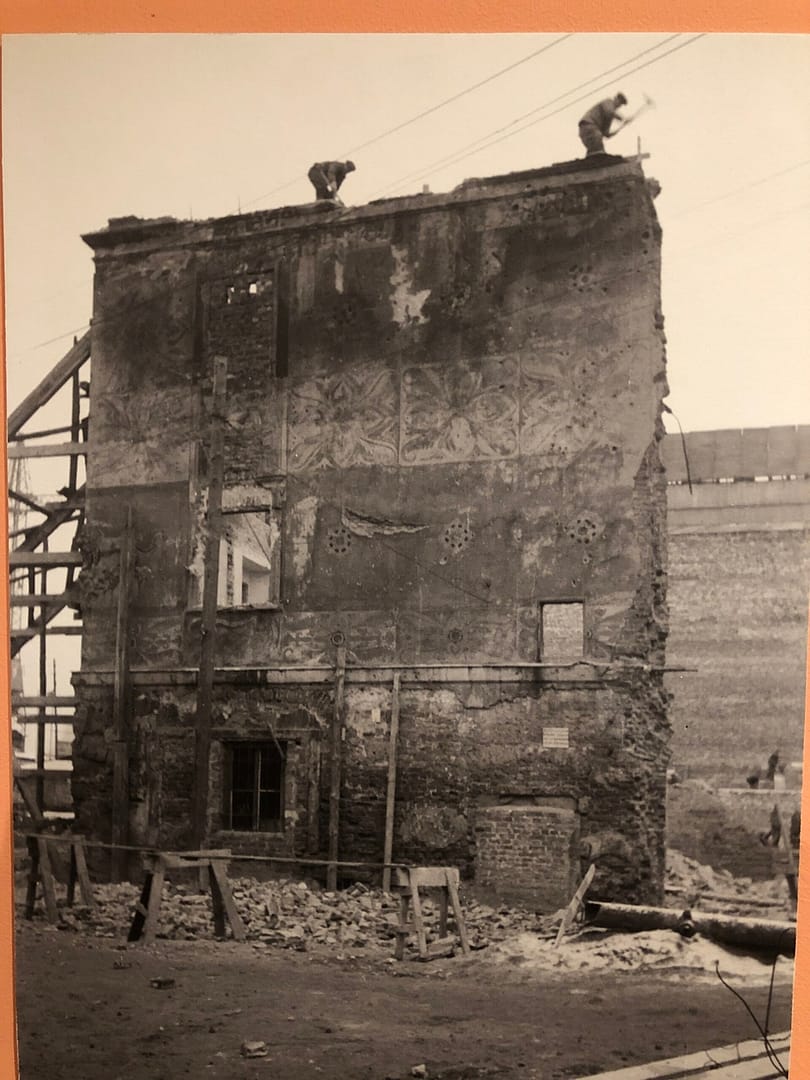I’m just back from the International Rapier Seminar, held in Warsaw last weekend. It was an absolute blast, so the first order of business is a heartfelt dziękuję/gracias/thank you to the organisers, especially Lorenzo Braschi for inviting me (he was the very man who introduced me to the mighty porrón in Spain in 2012), and to Karol for driving all the way out to the Ryanair airport to get me, which was only marginally closer to Warsaw than it is to my house.
The event kicked off at 5pm on the Friday, so I spent the day in Warsaw being a tourist, mostly at the Warsaw Museum, which had a special exhibition on the reconstruction of Warsaw after the Nazi’s wantonly destroyed it (as in, 65% of the city completely levelled, 80% badly damaged) after the Uprising of 1944. I didn’t know much about the city before I got there, and it frankly blew me away. The sheer scale of the clearing and rebuilding beggars the imagination, especially when you realise it was done with picks, shovels, and horse-drawn carts, in a country ravaged by the war.
Walking around the old town, you wouldn’t immediately guess that the buildings were built 70 years ago.
The event began with a get-together, a bit of sparring and lots of chatting, and I got to meet a student I’ve been interacting with pretty much weekly since 2020 (hi Jas!). I taught two classes on the Saturday: How to Train, followed immediately by How to Teach. I can summarise them for you like so:
1. Run a diagnostic, fix the weakest link, run the diagnostic again
2. Generate the optimal rate of failure in your student/s.
Simple, yes. Easy? Not so much. But that’s why we practice, right? The classes were well attended, and I think well received. During the afternoon I dropped in and out of watching classes by the other instructors, and got to fence with Emilia Skirmuntt, she of episode 75 of the podcast. Plus a great catch-up with Alberto Bomprezzi, whom I haven’t seen since my trip to Spain in 2012, and meeting Jorge from Mexico who persuaded me to part with my proof copy of The Duellist’s Companion Second Edition.
There may or may not have been much carousing and revelry that evening…
Sunday was given over to the tournament, which had two excellent features: it didn’t occupy all the space, and I didn’t have to do any work on it. So I spent the day fencing people! Elmar, Radek (who went on to win the tournament, congratulations!), Chris, Heikki (the one Finn at the event), Cornelius, and Martin. Each bout was different, each one delightful in its own way. If I had them to give, I’d give out the special technical “this feels like fencing a specific historical system” award to Martin (organiser of Swords of the Renaissance, which I attended last year and will return to in September this year). We were both really tired (these events are exhausting), but there were moments when it felt like Capoferro and Fabris might not have been ashamed of us. Another highlight was working with Damian on grounding and mechanics. He’d asked for it in my class the day before, but we didn’t have time to go into sufficient detail. There's no substitute for working one-on-one with students.
I was too knackered by the heat to fence everyone I wanted to, so Pedro Velasco and Tomasz Kraśnicki, here’s your rain-check for my first two bouts next time!
The great thing about all the bouts, and the event itself really, is that it was all very collegial. There was plenty of competitive spirit, but none of the personality-driven jockeying for status etc. that can make fencing unpleasant. That’s down to the attendees, in part, but also to the spirit of the event itself, for which the organisers should be thoroughly applauded.
Dinner on Sunday night was a blast too; most of the attendees had gone home, but on my table at a restaurant in a square in the old town, there were 8 people, no two of them from the same country. We had the USA, UK, Denmark, Serbia, Bosnia, Finland, Denmark, and Italy represented. If I went on a bit much about flying and woodwork, then Marc, Nic, Nicole, and Vicky, my apologies. Blame the vodka! But to be fair, they did ask…
And breakfast on Monday involved an hour-long chat with Ton Puey, Chris Lee-Becker, and Pedro Velasco. I think that a huge part of the value of events like these is the unscheduled serendipitous interaction with colleagues and friends. I also found at least two new guests for the podcast whom I had never heard of before the weekend!
My main takeaways from this trip are 1) I should do more of them and 2) I need to work on my fencing fitness. My legs are killing me!
As is now traditional, the day after an event like this I'm flooded with Facebook friend requests, which is lovely, but I don't use Facebook. So, if you'd like to find me on social media, come to swordpeople.com and say hello!








